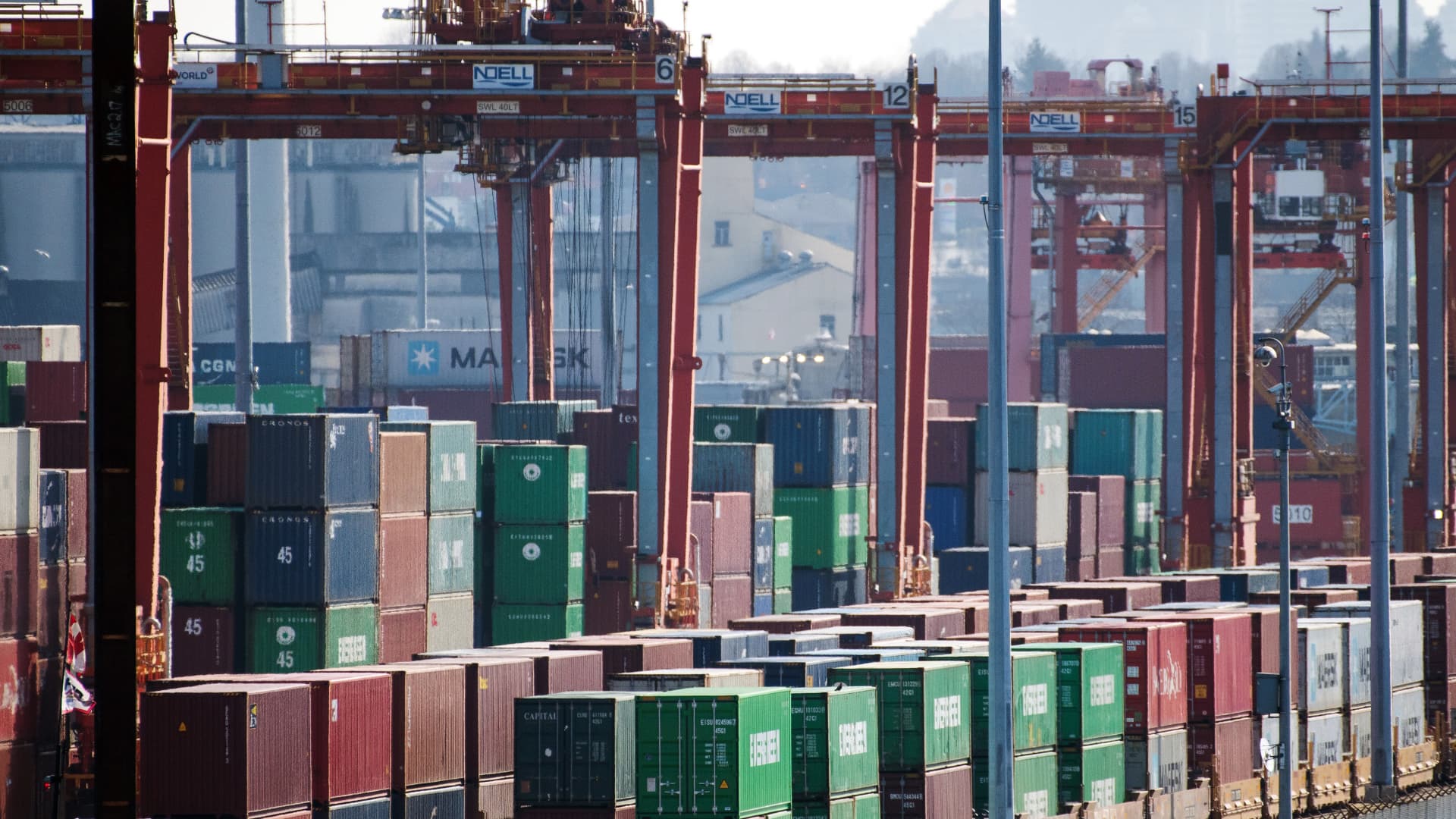Sea containers are loaded onto railcars at Global Container Terminals’ Vanterm Container Terminal in the Port of Vancouver, British Columbia, Canada.
Bloomberg | Bloomberg | Getty Images
Weekly rail trade data from the Association of American Railroads shows strikes at Canadian west coast ports have had a devastating impact on freight rail cargo entering the U.S.
Canadian rail intermodal fell 46.2% year-over-year last week due to strikes. The sectors most affected include forest products such as lumber and wood products, petroleum and petroleum products, non-metallic minerals such as gravel, sand, stone, clay and glass products, and chemicals.
AAR said in a statement that while the Fourth of July holiday may have played a role in the drop in trade volumes, “this drop in traffic is a concrete indicator of the impact of strikes at western Canadian ports on rail customers and the larger North American economy. The longer this continues and persists, the greater the impact on the North American supply chain.”
According to U.S. Census data, about $572 million in containerized trade arrives in the U.S. from Canada every day. Between January 2022 and May 2023, U.S. imports of goods from Canada totaled between $31 billion and nearly $41 billion per month. Top imports in May included mineral fuels, vehicles and computer-related machinery.
The International Longshoremen and Warehouse Federation of Canada began a strike on July 1. Negotiations between Canada’s ILWU and the British Columbia Maritime Employers Association have been tense, with both sides talking to federal mediators to reach an agreement.
The United States and Canada have historically had a strong trade relationship: each country is the other’s largest trading partner. About 20 percent of U.S. trade arrives at the Canadian ports of Vancouver and Prince Rupert, where strikes erupted after union leadership and industry representatives failed to reach an agreement before a cooling-off period expired. The Canadian Chamber of Commerce estimates that $605 million in trade passes through one of the two ports every day.
For every day the strike lasts, it could take three to five days for networks and supply chains to recover, according to estimates by the Canadian Railway Association. This means that if the strike ends on the twelfth day, delays for rail containers could be as long as 36 to 60 days. This does not include delays to ships waiting to be processed, which would add multiple additional delays.

Ship diversions and redistribution of containers on other ships as U.S. cargo will increase cargo volumes bound for the U.S. Paul Brashier, vice president of haulage and intermodal for ITS Logistics, said the rail system. It also adds time and costs, such as additional rail charges, customs fees and port handling charges.
The decline in trade volumes reflected some ships leaving Vancouver and Prince Rupert to divert cargo to the United States.Disruption in trade volumes raises concerns about U.S. supply chains
ITS has changed its freight index for rail ramps on the U.S. West Coast and East Coast to red, indicating future congestion due to strikes.
“Due to the duration of the strike, container wait times in Western Canada have increased, and when cargo finally begins to move from the marine terminals to the Inner Point rail ramp, freight will flood the rail lines and ramps,” Brashear said.
According to VesselsValue, there are currently 14 container ships berthing off the coast of Vancouver and Prince Rupert, with trade worth $7.6 billion.
“A fair amount of product flows from Asia through Vancouver and then on to places like Chicago by rail,” said Eric Byer, chief executive of the National Association of Chemical Distributors. He said some members are now on strike. There was a delay of three to four weeks, but he added that there was excess capacity in the market, so the situation was not at the level of a crisis that would have occurred had it not happened at U.S. West Coast ports. A deal was recently reached. “But (this) is still troubling. The strike will not last for weeks, otherwise the pressure on the supply chain will become challenging again,” Beyer said.
According to the National Association of Chemical Distributors, products from Asia used in paints, coatings and acids were the most affected.
U.S. ports still serving diverted ships despite union say
ILWU President Willie Adams, who returned to Canada for Sunday’s union rally for the second time since July 4, told CNBC in a recent statement that union workers would not be servicing any re-routed ships , but activity at U.S. ports suggests that is not the case. Vessels such as OOCL San Francisco, MSC Sara Elena, Hyundai Faith and CMA CGM Medea have all been repaired. However, it has been difficult for the ILWU to identify containers whose final destinations have changed because union staff cannot access container information for security reasons.
ILWU’s US West Coast chapter did not respond to a request for comment.
In a statement on Twitter on Tuesday, Canada’s labor minister said the disagreement between the union and port ownership was not enough to cause a shutdown, and he tasked senior federal mediators with drafting an agreement to present to both parties. The Labor Department told CNBC that the union and port management have now received the settlement proposal and have until 10:30 a.m. PT on Thursday to respond.
The government’s action would not stop the strike, and unions responded harshly to the Labor secretary after his initial statement.
Rob Ashton, ILWU Canada Chair, said: “The federal government will not intervene to impose contract terms on shipping lines that protect Canadians from cost and disruption, and now advocates that the government should force longshore workers back to work Post, it’s pure hypocrisy.”
Wages have been a key sticking point in failed negotiations, with the ILWU emphasizing that wages cannot keep up with inflation. The real purchasing power of dock wages has declined by 2.5 per cent since 2017, and dock wages have grown at a slower rate than wages in the Canadian economy as a whole, the report said.
On Wednesday, the Bank of Canada raised its benchmark interest rate to a 22-year high of 5%, with hawkish comments saying further rate hikes may be needed to fight inflation even as consumer prices have fallen from last year. High Point.
In order for unions to return to work without a labor deal, Canada’s parliament would have to be recalled, a politically unattractive option. If parliament is recalled, it will take days and a quorum is required for a legal vote to take place.
Steve Lamar, chief executive of the American Apparel and Footwear Association, recently told CNBC that any disruption to the supply chain, including this strike, would create inflation and inventory challenges during peak shipping season. His group has called for parliament to be recalled to help overcome the biggest hurdle right now: access to cargo stuck on ships or diverted to other ports.


